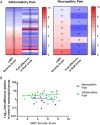Sez6 levels are elevated in cerebrospinal fluid of patients with inflammatory pain-associated conditions
- PMID: 31041421
- PMCID: PMC6455686
- DOI: 10.1097/PR9.0000000000000719
Sez6 levels are elevated in cerebrospinal fluid of patients with inflammatory pain-associated conditions
Abstract
Introduction: Seizure-related protein 6 (Sez6) contributes to chronic pain development as sez6 knockout mice show attenuated pain behaviours after peripheral nerve injury, compared with control mice. The type I transmembrane isoform of Sez6 is cleaved by the β-amyloid precursor protein cleavage enzyme 1 (BACE1), resulting in Sez6 extracellular domain shedding from the neuron surface.
Objectives: To determine whether this BACE1-shed form of Sez6 can be detected in the cerebrospinal fluid (CSF) and whether Sez6 levels in the CSF are altered in neuropathic pain or chronic inflammatory pain (IP).
Methods: We analysed the CSF samples collected during surgery from patients with chronic neuropathic pain (n = 8) or IP (n = 33), comparing them to the CSF samples from patients with suspected subarachnoid haemorrhage that was subsequently excluded (nonsurgical group, n = 5). Western blots were used to determine the relative Sez6 levels in the CSF from the different patient and nonsurgical comparison groups.
Results: The results show that BACE1-shed Sez6 can be readily detected in the CSF by Western blot and that the levels of Sez6 are significantly higher in the IP group than in the nonsurgical comparison group.
Conclusion: The association between elevated Sez6 levels in the CSF and IP is further evidence for persistent alterations in central nervous system activity in chronic IP conditions.
Keywords: BACE1; CSF; Chronic pain; Inflammatory pain; Seizure-related protein 6.
Conflict of interest statement
Sponsorships or competing interests that may be relevant to content are disclosed at the end of this article.
Figures



References
-
- Boyden SD, Hossain IN, Wohlfahrt A, Lee YC. Non-inflammatory causes of pain in patients with rheumatoid arthritis. Curr Rheumatol Rep 2016;18:30–8. - PubMed
-
- Dray A, Perkins M. Bradykinin and inflammatory pain. Trends Neurosci 1993;16:99–104. - PubMed
-
- Dworkin RH, Backonja M, Rowbotham MC, Allen RR, Argoff CR, Bennett GJ, Bushnell MC, Farrar JT, Galer BS, Haythornthwaite JA, Hewitt DJ, Loeser JD, Max MB, Saltarelli M, Schmader KE, Stein C, Thompson D, Turk DC, Wallace MS, Watkins LR, Weinstein SM. Advances in neuropathic pain: diagnosis, mechanisms, and treatment recommendations. Arch Neurol 2003;60:1524–34. - PubMed
-
- Gunnersen JM, Kim MH, Fuller SJ, De Silva M, Britto JM, Hammond VE, Davies PJ, Petrou S, Faber ES, Sah P, Tan SS. Sez-6 proteins affect dendritic arborization patterns and excitability of cortical pyramidal neurons. Neuron 2007;56:621–39. - PubMed
Grants and funding
LinkOut - more resources
Full Text Sources
